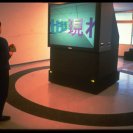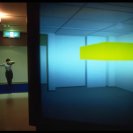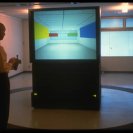In this installation at the International Art & Science Exhibition a large, back projected high-resolution monitor was mounted on a motorised turntable. An infra-red joystick controlled the 360-degree rotation of this screen and the synchronous rotation of the viewer's point of view in the computer-generated scene. This joystick also allowed the viewer to move his point of view forwards and backwards in the scene.
The computer-generated imagery showed a room that reproduced the appearance and proportions of the real room accommodating the installation. The virtual space (the image on the the screen) and the real space (the room) were optically aligned so that the viewer facing a door or a window in the real room would also be facing the same features in the simulated room. In this way Alice's Room set up a conjunction of virtual and actual spaces enabling reality and fiction be physically interpolated.
Four computer-generated objects were added in this simulated environment - red, green, yellow and blue rectangular boxes in the corners of the room. When entered, each box became a room interior which looked exactly like the outer room while at the same time possessing unique characteristics. The first room showed the four coloured boxes in a continuous circulating process of splitting into thirty-two smaller boxes and then reassembling themselves. The second room showed two rows of large moving Japanese characters - a haiku written specially by Shuntaro Tanikawa. The third room contained a slowly rotating wire-frame hypercube. At the centre of the fourth room was a continuously turning replica of the actual video monitor. While this simulated monitor had a blank white screen, moving coloured reflections on the walls of the room conveyed the impression that it was being illuminated by images on this empty screen.
Credits:
Software: Gideon May
Hardware: Huib Nelissen and Floris van Manen









